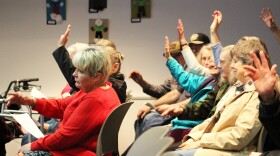The Kenai Peninsula Economic Development District, or KPEDD, is asking for feedback on an update to their comprehensive economic development strategy for the borough. That strategy document, called the CEDS, covers a five-year period, but is updated annually.
Cassidi Cameron is KPEDD’s executive director. She took over as head of the organization from Tim Dillon at the beginning of this year, and delivered her first quarterly report to members of the Kenai Peninsula Borough Assembly earlier this month. More than a fifth of the organization’s revenue for the upcoming fiscal year will come from the borough. The organization is a conduit for money flowing into the borough from outside sources, such as those made available through the federal Infrastructure Investment and Jobs Act, or IIJA.
“With the IIJA funds that are the federal funding opportunities that are coming through the state right now, it is a really important historic time for us to make sure that the projects and the focus that is listed in the CEDS are representative and can also coincide with federal funding opportunities,” she said.
KPEDD’s comprehensive economic development strategy is a big deal for the Kenai Peninsula. The document outlines the peninsula’s long-term economic priorities and is used to help secure federal funding for borough projects and initiatives. Projects that can be placed under a CEDS goal may more easily access funding opportunities.
The draft CEDS update currently being considered by KPEDD outlines the Kenai Peninsula economy’s strengths, weaknesses, opportunities and threats.
“What this does is it kind of gives us a broad overview of what are the things that we are focused on for the next not just one year but a five year strategy on economic development,” Cameron said.
For example, government and business resources, healthcare and natural resources are among the peninsula’s strengths, while declining school enrollment, changes to fishery policies and housing availability are examples of weaknesses.
The draft also presents an action plan of ways to achieve the overarching goal of the original CEDS document, which was to maintain and cultivate the Kenai Peninsula’s high quality of life. The document breaks out objectives like technology, workforce, infrastructure, entrepreneurship and regional partnerships.
Workforce development has been an ongoing focus of KPEDD’s. In 2021, the organization debuted a website designed specifically to help connect people to job opportunities on the peninsula. KPEDD also dedicated a presentation at its annual Industry Outlook Forum to the peninsula’s job market.
The Kenai Peninsula has gained more than eleven hundred [WEB 1,100] jobs from pre-pandemic levels, which Cameron said is trending above the rest of the state. She said there aren’t as many people, though, to work those jobs.
“Creating opportunities and mapping those out for young people is really important,” she said. “When I was 16, I didn't really have a map and so we're trying to make sure that our youth has a map. And also just not our 16 to 17, 18 year olds, but 22 year olds, 24 year olds that don't necessarily want to go through the traditional pathway for college, but maybe want a skill or a technical vocation. And we want to make sure that they have that map, too.”
There are other factors working in the economy’s favor, she said. The peninsula’s unemployment rate is low — around 4.6% — and Cameron said nearly all peninsula industries have recovered from pre-pandemic numbers. The number of people living on the peninsula is also going up, the opposite of the trend in most Alaska boroughs.
As KPEDD works to finalize this year’s CEDS update, Cameron said the input of communities from around the borough will be important. That’s why the organization is actively seeking feedback on the draft revision.
“I don't think that this is the time to work in silos,” she said. “I do think that working collaboratively on some of these projects is really going to take us further down the road and make the dollars go further and make our quality of living go higher.”
The draft version of KPEDD’s update to the peninsula’s CEDS document can be accessed on KPEDD’s Instagram page. The 30-day comment period closes next Thursday, June 20.







